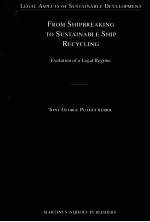

FROM SHIPBREAKING TO SUSTAINABLE SHIP RECYCLING EVOLTION OF A LEGAL REGIMEPDF电子书下载
- 电子书积分:11 积分如何计算积分?
- 作 者:TONY GEORGE PUTHUCHERRIL
- 出 版 社:MARTINUS NIJHOFF PUBLISHERS
- 出版年份:2010
- ISBN:9004174915
- 页数:290 页
Chapter 1 Introduction 1
Ⅰ.Background 1
Ⅱ.A Note on Terminology 7
A Final Note on Terminology 8
Chapter 2 The Global Business of Shipbreaking 10
Ⅰ.Introduction 10
Ⅱ.The Shipbreaking Industry: An Overview 12
Ⅲ.Shipbreaking Yards on the Indian Subcontinent or Toxic Hotspots? 26
A.Bangladesh: The Market Leader 27
B.Shipbreaking in Pakistan 29
C.Shipbreaking in India 30
1.The Final Journey to Alang 32
2.Placing Profits before People: The Human Costs of Shipbreaking 33
3.Environmental Consequences 36
D.Shipbreaking in China 38
E.Emerging Scenario 39
Ⅳ.Shipbreaking in the OECD Member States 40
A.Turkey: The Major Player in the OECD 41
B.The European Union Waste Shipment Regulations 43
C.Shipbreaking in the United States: Exorcising the Ghost Fleet 46
D.Perpetuating Environmental Racism 51
Ⅴ.Conclusion 51
Chapter 3 Limitations of a National Response to Regulate the Global Shipbreaking Industry: A Study of the Indian Experience 53
Ⅰ.Introduction 53
Ⅱ.The Legislative Framework for Ship Recycling: Rules and Laws Applicable in Alang 54
A.Protecting Labour and the Environment 54
B.The Ship Recycling Legal Regime 59
C.Shortcomings to the Ship Recycling Regulation in India 63
Ⅲ.Shipbreaking and Sustainability through the Judicial Lens 65
A.Development of Indian Environmental Jurisprudence 65
B.The Supreme Court of India, Hazardous Wastes Management and Shipbreaking 70
1.The Supreme Court Guidelines on Sustainable Ship Recycling 70
2.Strengthening the Guidelines on Sustainable Shipbreaking: One Step Forward, Two Steps Back 74
3.Toxic Ships and Progressive Dilution of the Guidelines 76
i.The ‘Riky’ 77
ii.The ‘Clemenceau’ 81
iii.The ‘Blue Lady’ 86
4.Justice to the Junkyards: A Mirage? 99
Ⅳ.The Economics of Shifting Ship-Scrap Markets and Efficacy of National Legal Regimes 101
Ⅴ.Conclusion 102
Chapter 4 Contemporary International Law and Ship Recycling 104
Ⅰ.Introduction 104
Ⅱ.Ship Dismantling and International Hazardous Waste Management Law 105
Ⅲ.Shipbreaking and the Law of the Sea 116
Ⅳ.Safe Shipbreaking and the International Labour Organization 119
Ⅴ.International Maritime Law and Ship Recycling 122
A.Dumping Obsolete Ships: The London Convention and its 1996 Protocol 122
B.Recycling Shipwrecks and the Wreck Removal Convention 126
C.The Anti-Fouling Systems Convention and Ship Recycling 128
D.Aquatic Nuisance Species, the Ballast Water Convention and Ship Recycling 130
E.Ship Recycling and MARPOL 73/78 133
F.The IMO Guidelines on Ship Recycling, 2003 134
Ⅵ.Conclusion 143
Chapter 5 Deciphering the Ship Recycling Convention 145
Ⅰ.Introduction 145
Ⅱ.Salient Features of the Ship Recycling Convention 147
A.Applicability 150
B.Ban on Trade between Parties and Non-Parties 151
C.Identification of Major Actors 151
1.Responsibilities of the Flag State 152
2.Recycling State 155
3.Authorised Ship Recycling Facilities 156
i.Ship Recycling Facility Plan 156
ii.Emergency Preparedness and Response Plan 157
iii.Worker Safety and Training 157
iv.Ship Recycling Plan 158
v.Ensuring Safe and Environmentally Sound Management of Hazardous Wastes 159
vi.Preventing Adverse Effects to Human Health and the Environment 160
4.Shipowner 160
5.Port State Control 161
6.Reporting Requirements 162
7.Hazardous Materials in the Design, Construction, Operation and Maintenance of Ships 163
8.Cooperation and Technology Transfer 163
9.Enforcement and Compliance 164
10.Relation to Other International Instruments 164
11.Communication and Exchange of Information 165
12.Dispute Settlement 165
13.Summary of the Ship Recycling Process 166
Ⅲ.The Ship Recycling Convention, IMO Guidelines, Basel Convention and Dilution of the Principle of Equivalency 167
A.The Ship Recycling Convention Compared to the Basel Convention 175
1.Illegal Traffic as a Criminal Act 175
2.Express Recognition of the Sovereign Right to Prohibit an Import 176
3.National Waste Management Capacity 176
4.Prior Decontamination of Ships 176
5.State of Export v.the Flag State and Flags of Convenience (FOC) Regime 177
6.Proximity Principle v.Not in My Back Yard Syndrome (NIMBY) 177
7.The Principle of Prior Informed Consent 178
8.Trade between Parties and Non-Parties 179
9.Applicability of Basel Convention in Light of Article 15 and Regulation 3 of the Ship Recycling Convention 180
B.The IMO Guidelines on Ship Recycling and the Ship Recycling Convention 180
C.Other Deficiencies in the Ship Recycling Convention 182
Ⅳ.Conclusion 189
Chapter 6 Conclusion 191
Ⅰ.Towards a Sustainable International Legal Regime on Ship Recycling 191
Ⅱ.The Way Forward 196
A.Developing “Green Capacity”: Replacing Beaching by More Acceptable Methods 196
B.Need for a Ship Recycling Contract 197
C.Prior Decontamination of Hazardous Materials 198
D.Responsibility of Organisation for Economic Co-operation and Development (OECD) Countries 199
E.Responsibilities of Third World Governments 200
F.Promoting Safety in the Recycling Yards 201
G.Promoting a Green Culture 201
H.Transparency 202
I.Greater Flag State Responsibilities 203
J.Application of the Polluter Pays Principle and Creation of a Ship Recycling Fund 203
K.Responsibility of the IMO 205
Appendix Hong Kong International Convention for the Safe and Environmentally Sound Recycling of Ships, 2009 209
Bibliography 257
Index 285
- 《英国近代早期传记名篇》(英)乔治·卡文迪什(George Cavendish),(英)艾萨克 2019
- 《十九世纪文学主流 第5分册 法国的浪漫派》(丹)勃兰兑斯(George Brandes)著 1997
- 《女人的故事》(英)乔治(W.L.George)著;胡学勤译 1928
- 《开发你的脑力》布任(Tony Buzan)著;詹求孚,陈芳智译 1989
- 《水上音乐 净本》乔治·弗里德里克·亨德尔(George Frideric Handel)作曲;罗杰·费斯克(Roger Fiske)编订 2008
- 《尼贝龙根的指环--完美的华格纳》萧伯纳(GEORGE BERNARD SHAW)著;林筱青,曾文英译 2003
- 《战后欧洲六十年 卷4 新欧洲 旧欧洲 1989-2005》东尼·贾德(TONY JUDT)著;黄中宪译 2013
- 《战后欧洲六十年 卷2 繁荣与革命 1953-1971》东尼·贾德(TONY JUDT)著;黄中宪译 2012
- 《欧元美金大风暴》索罗斯(GEORGE SOROS)著;李隆生译 2012
- 《地质家测井分析基础》GEORGE ASQUITH,CHARLES GIBSON编 1984
- 《轻松学用Publisher 2000 中文版》(美)(J.麦卡特)Jim McCarter著;卢凌云等译 1999
- 《办公自动化Office 2000》本书编委会编 2000
- 《Microsoft Publisher 2000即学即会》(美国前景公司)Perspection著;北京博彦科技发展有限公司译 1999
- 《Publisher 2000 中文版快递》东箭工作室编著 1999
- 《Publisher 2000简明操作手册》秦颂编著 2000
- 《商品展示 引进版》(美)Robert Colborne著;张艳玲,陈平主译 2005
- 《中文版Office 2013宝典 第4版》(美)布茨基著 2014
- 《PhotoDraw 2000和Publisher 2000中文版使用速成》康博创作室编著 2000
- 《商务软件应用必备》郝志华,王涛编著 2001
- 《中文版Office 2003七合一实用培训教程》赵斌,卢盾编著 2004
